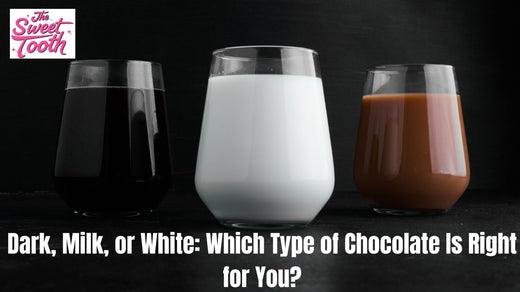
Dark, Milk, or White – Which Type of Chocolate Is Right for You?
Introduction
Chocolate is one of the most beloved indulgences across the globe, offering a wide range of tastes, textures, and experiences. Whether it’s the rich and bitter allure of dark chocolate, the smooth and creamy sweetness of milk chocolate, or the delicate sweetness of white chocolate, each variety has its unique appeal. But with so many options, how do you choose the right chocolate for you?
This article explores the differences between dark, milk, and white chocolate to help you make an informed decision.
Understanding Chocolate Varieties
Chocolate’s magic lies in its blend of cocoa, sugar, and milk solids, but the proportions of these ingredients vary significantly between types. Understanding what goes into each type of chocolate helps uncover the reasons behind their distinct tastes and textures. From the deep cocoa richness of dark chocolate to the milky sweetness of white chocolate, each variety offers something unique for every palate.
What Is Dark Chocolate?
Dark chocolate is known for its deep, rich flavor that can range from bittersweet to slightly sweet depending on the cocoa content. Unlike milk chocolate, it contains little or no milk solids and has a higher percentage of cocoa. The higher the cocoa content, the more intense and bitter the chocolate becomes.
-
Health Benefits of Dark Chocolate
Dark chocolate is packed with antioxidants, particularly flavonoids, which can have numerous health benefits, including improved heart health and cognitive function. Studies suggest that consuming dark chocolate in moderation can lower blood pressure, improve blood flow, and even enhance mood.
-
Popular Brands and Varieties
Dark chocolate is available in many forms, ranging from 50% to 100% cocoa, and popular brands like Lindt, Ghirardelli, and Green & Black’s offer a variety of dark chocolate products. Some dark chocolates even include added spices, fruits, or nuts, enhancing the tasting experience.
What Is Milk Chocolate?
Milk chocolate is the most commonly consumed type of chocolate. It’s made by combining cocoa, sugar, and milk solids, creating a much sweeter and creamier product than dark chocolate. The inclusion of milk powder or condensed milk makes it less bitter and more accessible to those who prefer a milder flavor.
-
The Appeal of Milk Chocolate
Milk chocolate is known for its smooth and velvety texture, making it a favorite for those who enjoy a balanced sweetness. It’s often the go-to chocolate for children and those who find dark chocolate too intense.
-
Top Milk Chocolate Products
Iconic milk chocolate products include Hershey’s Milk Chocolate Bars, Cadbury Dairy Milk, and Milka. These brands have become synonymous with comfort and nostalgia, offering consistent quality and flavor in every bite.
What Is White Chocolate?
White chocolate is distinct from both dark and milk chocolate because it doesn’t contain cocoa solids. Instead, it’s made from cocoa butter, sugar, and milk solids, giving it a creamy, buttery texture. While technically not “true” chocolate since it lacks cocoa solids, white chocolate offers a unique and indulgent sweetness.
-
Unique Features of White Chocolate
White chocolate is known for its rich and sweet flavor profile with hints of vanilla. Its creamy texture makes it ideal for those who love a less bitter, more sugar-forward taste. Despite its sweetness, it lacks the complex bitterness found in dark chocolate, offering a different kind of chocolate experience.
Health Considerations: Which Chocolate Is Healthier?
When it comes to health, dark chocolate is often considered the healthiest option due to its higher antioxidant content and lower sugar levels. The flavonoids in dark chocolate are believed to support heart health and cognitive function.
-
Milk Chocolate’s Nutritional Profile
While milk chocolate is richer in sugars and fats, it still offers some nutritional benefits, including calcium from the milk solids. However, its sugar content may outweigh any benefits for those seeking healthier alternatives.
-
White Chocolate and Its Sugar Content
White chocolate, due to its sugar-heavy composition, is generally considered the least healthy option. It has a high glycemic index and lacks the beneficial cocoa compounds found in darker varieties.
Taste Test: How Do They Compare?
The most significant difference between dark, milk, and white chocolate lies in their taste profiles.
-
Dark Chocolate: Bold and Bitter
Dark chocolate’s high cocoa content imparts a deep, bitter flavor with slight hints of sweetness, making it a choice for those who enjoy intense, sophisticated tastes.
-
Milk Chocolate: Sweet and Creamy
Milk chocolate is the perfect balance of sweetness and creaminess, with a smooth texture that makes it universally loved.
-
White Chocolate: Sweet and Buttery
White chocolate offers a sweeter, more buttery taste, often with vanilla undertones, catering to those who prefer less bitterness.
Chocolate Pairing: Which Goes Best with What?
Pairing chocolate with complementary foods can elevate its taste and enhance your overall experience.
-
Pairing Dark Chocolate with Wines and Berries
Dark chocolate pairs beautifully with red wines, such as Cabernet Sauvignon or Merlot, as well as fresh berries like raspberries and strawberries, which enhance its rich flavors.
-
Milk Chocolate and Nutty or Fruity Combinations
Milk chocolate is great with nuts (like almonds or hazelnuts) and fruits (like bananas or peaches) due to its sweet, smooth profile.
-
White Chocolate’s Best Pairings
White chocolate pairs well with citrus fruits, such as oranges or lemon, as well as berries like strawberries and raspberries, which contrast its sweetness.
Which Chocolate Type Is Best for Baking?
Each type of chocolate lends itself to different baking applications.
-
Dark Chocolate in Desserts
Dark chocolate is ideal for making rich, decadent desserts like brownies, cakes, and ganaches. Its bitterness complements the sweetness of other ingredients and adds depth to the flavors.
-
Milk Chocolate in Cakes and Cookies
Milk chocolate’s creamy texture makes it perfect for cookies, cakes, and truffles, where a softer sweetness is preferred.
-
White Chocolate for Unique Flavor Profiles
White chocolate is perfect for adding richness and sweetness to cookies, muffins, and fillings, offering a unique flavor that contrasts with other ingredients.
Sugar Content: How It Affects Your Choice
The amount of sugar in chocolate plays a significant role in its flavor and health impact.
-
Dark Chocolate’s Low Sugar Content
Dark chocolate typically contains less sugar than milk or white chocolate, making it a more suitable option for those seeking to reduce sugar intake.
-
Milk Chocolate’s Moderate Sugar Content
Milk chocolate contains more sugar than dark chocolate but less than white chocolate, providing a balance of sweetness.
-
White Chocolate’s High Sugar Levels
White chocolate has the highest sugar content, which can be a consideration for those monitoring their sugar intake.
The Role of Cocoa Content in Dark Chocolate
Cocoa content directly impacts the flavor of dark chocolate.
-
What Does Cocoa Percentage Mean?
The percentage of cocoa in dark chocolate indicates how much of the product is made from cocoa solids, cocoa butter, and sugar. A higher percentage typically means a more intense and bitter taste.
-
Choosing the Right Cocoa Level for Taste Preferences
For those who prefer a milder taste, a cocoa content of 50-60% is ideal. If you enjoy a more intense flavor, aim for 70% or higher.
Chocolate and Mood: How Different Types Affect You
Chocolate has been linked to mood-boosting properties.
-
Dark Chocolate and Mental Clarity
Dark chocolate’s high levels of antioxidants can improve brain function and mental clarity, providing a boost to mood and concentration.
-
Milk Chocolate and Comfort
The smooth, creamy texture of milk chocolate provides comfort and relaxation, making it the perfect choice for indulgence.
-
White Chocolate’s Calming Effects
White chocolate, with its sweeter, buttery profile, has a calming effect, offering a gentle mood lift.
The Environmental Impact of Different Chocolate Types
The sourcing of cocoa impacts the environment.
-
Cocoa Sourcing for Dark, Milk, and White Chocolate
Dark chocolate typically uses more cocoa than milk or white, which can contribute to higher environmental costs. Choosing fair trade-certified brands can help mitigate this impact.
-
Fair Trade Certifications and Sustainability
Many chocolate producers are now focusing on sustainable practices, ensuring fair compensation for farmers and reducing environmental harm.
Allergies and Sensitivities: Which Chocolate Is Right for You?
For those with allergies, choosing the right type of chocolate is essential.
-
Lactose-Free Dark Chocolate Options
Dark chocolate is typically lactose-free, making it an excellent choice for those with lactose intolerance.
-
White Chocolate and Dairy Sensitivities
White chocolate contains milk solids, which may not be suitable for individuals with dairy sensitivities.
-
Vegan Milk Chocolate Choices
Vegan-friendly milk chocolates are available, offering a dairy-free option while still providing the creamy texture of traditional milk chocolate.
Conclusion: Finding Your Perfect Chocolate Match
Ultimately, the best type of chocolate comes down to personal preference. Whether you enjoy the intense bitterness of dark chocolate, the smooth sweetness of milk chocolate, or the creamy richness of white chocolate, each variety offers a unique experience. By considering factors such as taste, health benefits, and environmental impact, you can select the perfect chocolate to suit your needs and indulge in a satisfying treat.
